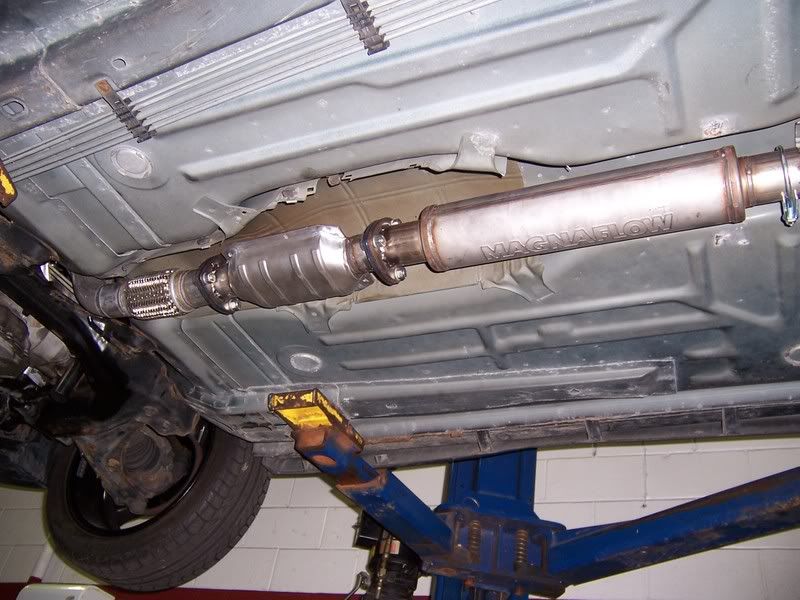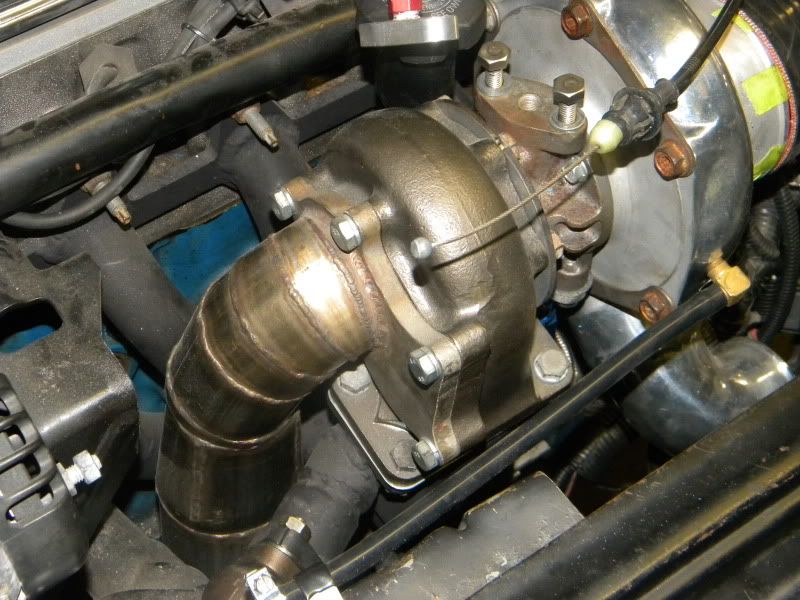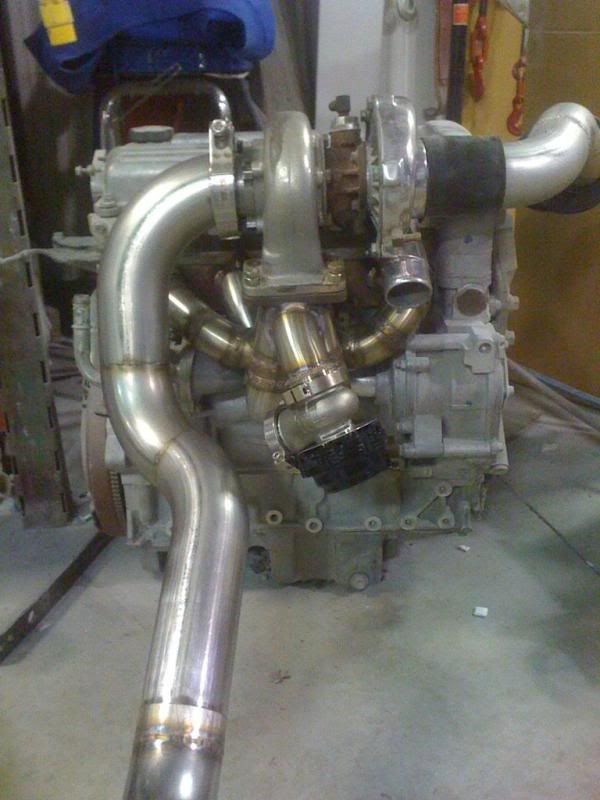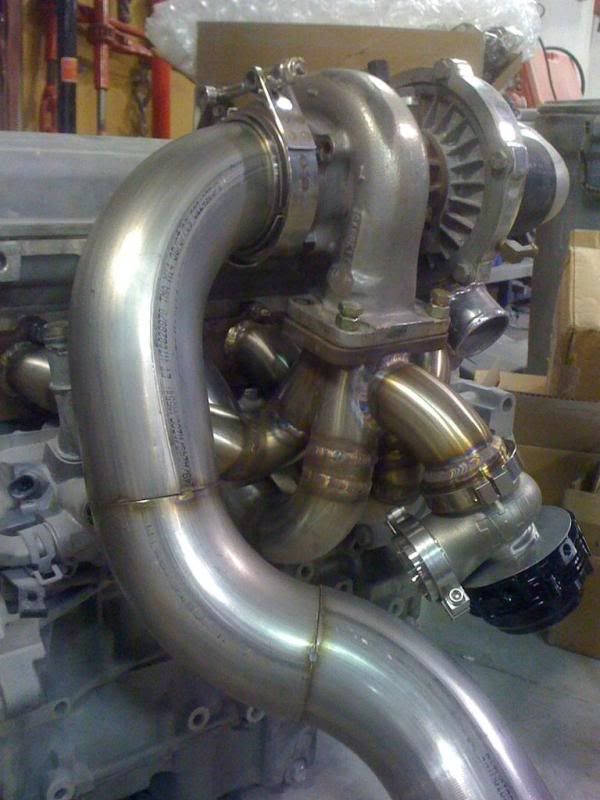OK all, Im going to be running a pretty standard turbo setup. 16G, intercooled, 10-12 PSI max. I'm needing to get my turbo downpipe fabricated. My question is, what is a good pipe size, and what does everyone recommend??? I have access to everything I need in 2.25" and was told that that would be just fine for my car. I've seen people on here run to 3" and they say that 3" is perfect. And there are others that say 2.5" is perfect.
I don't plan on running more than 10-12PSI max, and just after the downpipe, I will be upping to 2.5" high flow cat and possibly side exit exhaust. So what is everyones thoughts??? Will 2.25" be alright, or should I look for a bigger size to go with??? Thanks for everyones suggestions.

 Currently #4 in Ecotec Forced Induction horsepower ratings. 505.8 WHP 414WTQ!!!
Currently 3rd quickest Ecotec on the .org - 10.949 @ 131.50 MPH!!!
Currently #4 in Ecotec Forced Induction horsepower ratings. 505.8 WHP 414WTQ!!!
Currently 3rd quickest Ecotec on the .org - 10.949 @ 131.50 MPH!!!
I have a 2.5 inch downpipe, 3 inch after that, no cat, with a apexi WS2 muffler, probably the best sounding 4cyl I have heard, in my opinion.
And also, I dont think a 2.25 downpipe is a very good idea, doesnt flow enough, you would notice a longer lag then somebody running a 2.5inch downpipe I am sure. Just go 2.5. I dont think 3 inch is nessisary, maybe if I had a GT turbo, or something with a 3 inch exhaust outlet, then I would have done a 3 inch downpipe.
I'm not really comcerned about sound. My car could sound like a dying emu for all I care, haha. All I care about is decent performance. So is it a definate no on the 2.25" downpipe, or do others have any other opinions? Thanks for your input Fst Cavy, I really appreciate it!!!
 Currently #4 in Ecotec Forced Induction horsepower ratings. 505.8 WHP 414WTQ!!!
Currently 3rd quickest Ecotec on the .org - 10.949 @ 131.50 MPH!!!
Currently #4 in Ecotec Forced Induction horsepower ratings. 505.8 WHP 414WTQ!!!
Currently 3rd quickest Ecotec on the .org - 10.949 @ 131.50 MPH!!!
I had a 3" full exhaust from the turbo back, over the axle in my old Z24. Probably one of the reasons I was able to put down 221 WHP on just 8 psi with a really rough tune.
It's oh so cheesey!


im using 2.5 gets close to the fuel but going to wrap
If you care about performance stay away from 2.25, honestly unless you have a ln2 or 2200 2.25 is too small for a N/A build. I will personally be using a 3" but I would not use less than 2.5". Remember the less back pressure the happier the turbo, thats why you hear about people with factory turboed cars changing out the downpipe.

Josh G. wrote:
And what..... A 3" down pipe to 3" straight back exhaust on a fully built LN2.. people always gotta be ragging on the LN2 motors..
I worded that weirdly, I meant 2.25" was only acceptable on a N/A 2.2 LN2. When turboed the bigger the better ALWAYS no matter the engine.

Zs Z wrote:Josh G. wrote:
And what..... A 3" down pipe to 3" straight back exhaust on a fully built LN2.. people always gotta be ragging on the LN2 motors..
I worded that weirdly, I meant 2.25" was only acceptable on a N/A 2.2 LN2. When turboed the bigger the better ALWAYS no matter the engine.
Lol I was just giving ya a hard time plus it gave me an opportunity to show off my latest update since no one ever commentson my build thread!

It does look pretty badass!

Just go with whatever size the outlet of the turbine is, that's the correct size for the turbo as defined by the manufacturer.
1994 Saturn SL2 Home Coming Edition: backup car
2002 Chevy Cavalier LS Sport Coupe: In a Junk Yard
1995 Mazda Miata R-package Class=STR
Sponsored by:
Kronos Performance
WPI Class of '12 Mechanical Engineering
WPI SAE Risk and Sustainability Management Officer
My 16g will have a 2.5" downpipe and flare to 3" at the cat
Jason
99 Z24
LG0/LD9 for Life

10 Year Bash Veteren

im running 2.5" all the way back on 10psi. 3" is over kill unless your hp goals are high.
Leafy wrote:Just go with whatever size the outlet of the turbine is, that's the correct size for the turbo as defined by the manufacturer.
The only even PARTIALLY correct answer in this thread...
The outlet of the turbine dictates what size pipe you will want to run... generally a quarter inch bell outlet up to the exhaust pipe diameter is all you need. Do you realize how much more area you present for the exhaust gasses just upping one quarter inch?
my setup has an outlet of 2.25"... I used a flange that has a 2.25 hole, welded the pipe to the flange, and then blended the 2.25 to the 2.5" pipe.
You do realize that a 3 inch pipe will flow up to 600hp worth of air correct?
allowing exhaust to flow out of the turbo will help spool... but come on people.. a 2.25 inch T3 turbo exit or even smaller 16g outlet going up to 3 inch? Thats rediculous.
Some of you need to read
This...

Buildin' n' Boostin for 08' - Alex Richards
Alex Richards wrote:Leafy wrote:Just go with whatever size the outlet of the turbine is, that's the correct size for the turbo as defined by the manufacturer.
The only even PARTIALLY correct answer in this thread...
The outlet of the turbine dictates what size pipe you will want to run... generally a quarter inch bell outlet up to the exhaust pipe diameter is all you need. Do you realize how much more area you present for the exhaust gasses just upping one quarter inch?
my setup has an outlet of 2.25"... I used a flange that has a 2.25 hole, welded the pipe to the flange, and then blended the 2.25 to the 2.5" pipe.
You do realize that a 3 inch pipe will flow up to 600hp worth of air correct?
allowing exhaust to flow out of the turbo will help spool... but come on people.. a 2.25 inch T3 turbo exit or even smaller 16g outlet going up to 3 inch? Thats rediculous.
Some of you need to read This...
My car is at a professional speed shop and the goal is 500whp. 3" is dead on where I need to be.

Alex Richards wrote:Leafy wrote:Just go with whatever size the outlet of the turbine is, that's the correct size for the turbo as defined by the manufacturer.
The only even PARTIALLY correct answer in this thread...
The outlet of the turbine dictates what size pipe you will want to run... generally a quarter inch bell outlet up to the exhaust pipe diameter is all you need. Do you realize how much more area you present for the exhaust gasses just upping one quarter inch?
my setup has an outlet of 2.25"... I used a flange that has a 2.25 hole, welded the pipe to the flange, and then blended the 2.25 to the 2.5" pipe.
You do realize that a 3 inch pipe will flow up to 600hp worth of air correct?
allowing exhaust to flow out of the turbo will help spool... but come on people.. a 2.25 inch T3 turbo exit or even smaller 16g outlet going up to 3 inch? Thats rediculous.
Some of you need to read This...
I own max boost and have read it numerous times. Hell he's the one I got the whole, "if your turbine outlet is x size, no need for your downpipe to be bigger than x."
1994 Saturn SL2 Home Coming Edition: backup car
2002 Chevy Cavalier LS Sport Coupe: In a Junk Yard
1995 Mazda Miata R-package Class=STR
Sponsored by:
Kronos Performance
WPI Class of '12 Mechanical Engineering
WPI SAE Risk and Sustainability Management Officer
Leafy wrote:Alex Richards wrote:Leafy wrote:Just go with whatever size the outlet of the turbine is, that's the correct size for the turbo as defined by the manufacturer.
The only even PARTIALLY correct answer in this thread...
The outlet of the turbine dictates what size pipe you will want to run... generally a quarter inch bell outlet up to the exhaust pipe diameter is all you need. Do you realize how much more area you present for the exhaust gasses just upping one quarter inch?
my setup has an outlet of 2.25"... I used a flange that has a 2.25 hole, welded the pipe to the flange, and then blended the 2.25 to the 2.5" pipe.
You do realize that a 3 inch pipe will flow up to 600hp worth of air correct?
allowing exhaust to flow out of the turbo will help spool... but come on people.. a 2.25 inch T3 turbo exit or even smaller 16g outlet going up to 3 inch? Thats rediculous.
Some of you need to read This...
I own max boost and have read it numerous times. Hell he's the one I got the whole, "if your turbine outlet is x size, no need for your downpipe to be bigger than x."
For practical purposes, that's fine, but technically from a performance standpoint, that's incorrect. Sure there is a point of diminishing returns, but generally, a larger/higher flowing exhaust not only increases turbo response, but it also helps improve turbine efficiency and reduce EGT's. Technically, the ideal exhaust would be a flared or tapered "megaphone", which helps create an impedance match between the diameter of the turbine wheel and the atmosphere (think Helmholtz)...but this isn't really practical for anything short of a rail. Also, if you're running a CAT or muffler, those are restrictions to contend with, which reduce your effective diameter and therefore a larger exhaust makes even more sense..
I have no signiture
Right, I was referring to down pipes in a street driven application. And only down pipes.
1994 Saturn SL2 Home Coming Edition: backup car
2002 Chevy Cavalier LS Sport Coupe: In a Junk Yard
1995 Mazda Miata R-package Class=STR
Sponsored by:
Kronos Performance
WPI Class of '12 Mechanical Engineering
WPI SAE Risk and Sustainability Management Officer


















